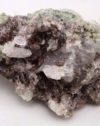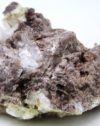HISTORY, NAME, LOCALITIES: Diopside, pronounced die-OPP-side, has been known since antiquity and was recognized as a mineral species in 1800. Its name is derived from the Greek words di, meaning “two,” and opisis, or “view,” literally meaning “double view” and alluding to the manner in which its strongly birefringent, transparent crystals create a double image. Fine diopside specimens are found in Italy, Switzerland, Austria, Madagascar, Russia, Canada, Australia, Guatemala, and the United States (New York, California, Vermont, Alaska).
MINERALOGY, PROPERTIES, OCCURRENCE: Diopside [calcium magnesium silicate, CaMgSi2O6] crystallizes in the monoclinic system as short, transparent-to-translucent prisms with well-developed terminations, and also as grainy masses. Well-developed crystals are uncommon. Color is most often some shade of green, but can range to white and gray. Diopside has a Mohs hardness of 5.0-6.0, perfect cleavage in one direction, a vitreous-to-dull luster, and a specific gravity of 3.3-3.6. It occurs in several mineralogical environments, including ultrabasic igneous rocks, carbonatites, and metamorphosed limestone.
METAPHYSICAL PROPERTIES, LORE, USES: The intense-green, chromium-rich variety of diopside is a valuable and attractive gemstone. Transparent crystals are faceted into small gems that are similar in color to emerald. Diopside has limited use in the manufacture of special ceramics. To metaphysical practitioners, diopside is an emotional healing stone that removes blockages that prevent the flow of tears, fosters recognition of personal strength with humility, and stimulates intellect and learning.
COLLECTORS’ INFORMATION: Diopside crystals of the chrome variety are collected for their rarity and intense-green colors.





 Axinite #10
Axinite #10  Axinite #8
Axinite #8